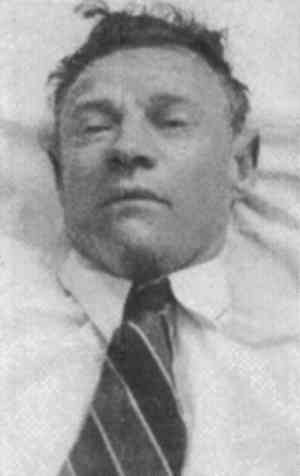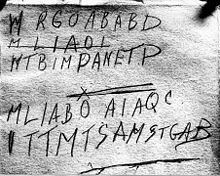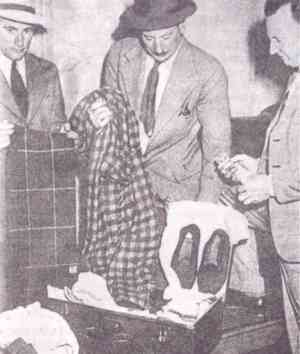It looks like you're using an Ad Blocker.
Please white-list or disable AboveTopSecret.com in your ad-blocking tool.
Thank you.
Some features of ATS will be disabled while you continue to use an ad-blocker.
share:
The following accounts of strange events remain the subject of mysteries and miracles to this day - the stories themselves are truly chilling in their
details. In some of these cases extensive scientific & forensic analysis has been undertaken leaving skeptics and believers scratching their heads as
to the cause and/or anomolies surrounding the case(s).
Although I have provided only a very brief account of the particular event and where possible pictures, I would encourage you to hit the link for the full story. There is a wealth of information from various sources online if you wish to explore any in further detail.
Enjoy......................
____________________________________________________________________________________________
1. The Bloop

noaa.gov
2. The Versailles Time-Slip.
Image of Charlotte Anne Moberly and Eleanor Jourdain

Kathleen McGowan
3. The Taman Shud Case

University of Adelaide case analysis 2009


4. The Cokeville mystery
Kajama.com

Angels Imprint

...................................................................
10 more cases to go......I'll post part 2 tomorrow (Sat 15th) and part 3 on Sunday.
Although I have provided only a very brief account of the particular event and where possible pictures, I would encourage you to hit the link for the full story. There is a wealth of information from various sources online if you wish to explore any in further detail.
Enjoy......................
____________________________________________________________________________________________
1. The Bloop

io9.com
This sound was repeatedly recorded during summer, 1997 on the Equatorial Pacific Ocean autonomous hydrophone array. The sound rises rapidly in frequency over about one minute and was of sufficient amplitude to be heard on multiple sensors, at a range of over 5,000 km. It yields a general location near 50oS; 100oW. The origin of the sound is unknown.
It originated from a point about 1,500 miles west of the southern Chilean coast. It was powerful enough to be picked up on sensors located up to 3,000 miles away, making it one of the most powerful noises ever recorded underwater. The sound lasted for just over a minute and has not been detected since.
It should be pointed out now that the NOAA has checked with the Navy and other groups to rule out human-made sources in this and the rest of these cases.
noaa.gov
2. The Versailles Time-Slip.
In August of 1901, Charlotte Anne Moberly and Eleanor Jourdain decided to visit the Palace of Versailles in France. As they were not impressed with the palace after touring it, they decided to walk through the gardens to the Petit Trianon. On the way, however, they learned that they were closed to the public that day and, instead, decided to explore the grounds some more.
Soon, the two ladies were lost and, as they put it, overcome with a feeling of weariness and oppression. Soon, they began to notice things that were out of place -- dignified officials in three cornered hats, an old plough and farmhouse, and other people and things that appeared as through they belonged more in a wax museum than the streets of 20th century Paris.
After many specific events, they eventually rejoined the party of other visitors. The strange feelings and visions of the past had vanished.
It was many months before the women told of their strange encounters. Visiting Versailles sometime later, the women were not able to find the landmarks that they had noticed during the incident.
Image of Charlotte Anne Moberly and Eleanor Jourdain

Kathleen McGowan
3. The Taman Shud Case

During the early morning of December 1, 1948, the body of a man was discovered on Somerton Beach in Australia. Little did the the authorities on the scene realize that they were about to witness the birth of a very strange mystery. The man discovered that day was in peak physical condition and as dressed very well, but all of the labels on his clothing had been removed. In his pocket was a train ticket for a ride he obviously missed on account of his being dead and all.
Although investigators believed that the man must have been poisoned, no traces of any foreign agent was discovered during an autopsy. Some still maintain that the Somerton Man died of some type of undetectable poisoning because there was no other explanation for his death. A month later police discovered a brown suitcase at Adelaide Railway station that might have belonged to the mysterious Somerton Man. The brown suitcase had its label removed just like the unidentified man’s clothing and inside were clothes that had also had the labels removed. Inside the bag was a stenciling brush, electrician’s screwdriver, and a pair of scissors normally used for stenciling. Unfortunately, the suitcase proved to be another dead end. With all leads non-existent, the months passed by until June of 1949 when investigators had the body reexamined and discovered a secret pocket in the man’s clothing that contained a scrap of paper with the words “Taman Shud” printed on it.
Upon a closer inspection of the paper it was discovered that the scrap came from a collection of poems entitled The Rubaiyat of Omar Khayyam. This discovery led to a media blitz in an attempt to find the book the page was torn from. The campaign was successful as a man stepped forward with a rare first edition copy of Edward Fitzgerald’s translation of The Rubaiyat, which he said he found in the back seat of his car the night before the unidentified man’s body was found. In the back of the book scrawled out faintly in pencil was a strange code. Also written in the book was the phone number of a former nurse who, while serving in World War II, gave a copy of The Rubaiyat to an army officer named Alfred Boxall. Boxall's copy of The Rubaiyat was still intact, though, and both parties denied any connection to the unidentified dead man.
Even now, after over 60 years, the mystery of the Somerton Man remains unsolved. No one knows who he was, what the phrase "Taman Shud" was supposed to mean, or what the mysterious code is supposed to represent. There has been speculation over the years that the man was a spy, but none of it has remotely been proven.
University of Adelaide case analysis 2009


4. The Cokeville mystery
The Cokeville Miracle is about an Elementary School hostage crisis that occurred on May 16, 1986, in Cokeville, Wyoming, United States, when former town marshal David Young, and his wife Doris Young, took 167 children and adults hostage at Cokeville Elementary School. David Young entered the school with his wife transporting a large gasoline-filled device that appeared to be a bomb. At one point Doris Young lifted her arm sharply and the bomb went off prematurely, injuring Doris Young while David Young was out of the room. Returning to the scene, David Young shot his wife, then himself. All the hostages escaped, though 79 were later hospitalized with burns and injuries.
Bomb experts remained baffled as the explosive should have leveled the entire building. The children maintain that they were visited by Angels whom told them to remain calm and that they would be saved
Kajama.com

Angels Imprint

...................................................................
10 more cases to go......I'll post part 2 tomorrow (Sat 15th) and part 3 on Sunday.
reply to post by Sublimecraft
dude dont be a d*ck just post all of them i am highly interested in this thread and with how the worlds going i want to hear the whole list before the world goes to sh*t
dude dont be a d*ck just post all of them i am highly interested in this thread and with how the worlds going i want to hear the whole list before the world goes to sh*t
reply to post by DocHolidaze
LOL
Had to star that response
No delay intended...
1. It takes about 45 mins per story just to gather the info
2. I've been away from the Wife & kids for 4 weeks and only arrived home yesterday
3. I'm on my 4th beer.
LOL
Had to star that response
No delay intended...
1. It takes about 45 mins per story just to gather the info
2. I've been away from the Wife & kids for 4 weeks and only arrived home yesterday
3. I'm on my 4th beer.
reply to post by Sublimecraft
i understand the kids thing but shove those little ones off to bed and get typing lol, il be watching for sure, flag and star broham
i understand the kids thing but shove those little ones off to bed and get typing lol, il be watching for sure, flag and star broham
S&F
I'd give you two if I could. I love this sort of thing and in all honesty I hadn't expected to see a case that I hadn't heard but the cokeville thing was new for me. So thanks for that. Hopefully a few more of your planned cases will be new for me as well. Also your post led me to the discovery of an additional incident which I am frankly supried to have nevern read about The Dyatlov Pass incident.
I'd give you two if I could. I love this sort of thing and in all honesty I hadn't expected to see a case that I hadn't heard but the cokeville thing was new for me. So thanks for that. Hopefully a few more of your planned cases will be new for me as well. Also your post led me to the discovery of an additional incident which I am frankly supried to have nevern read about The Dyatlov Pass incident.
reply to post by Josephus
Indeed - that incident will actually be covered in part 2 tomorrow
Thanks for the thumbs up.
Indeed - that incident will actually be covered in part 2 tomorrow
Thanks for the thumbs up.
reply to post by Sublimecraft
S&F for you! This was a really good read and i will be waiting for part 2 tomorrow!
S&F for you! This was a really good read and i will be waiting for part 2 tomorrow!
Yes, please keep them coming. This has definitely sparked my interest.
Cool thread, OP. Just hurry up though!
Cool thread, OP. Just hurry up though!
Just Google the stuff. I'd do it if I were really that interested. I'm pretty sure spontaneous combustion, disappearances, and Bigfoot will also
appear in this list.
I'll keep an eye on the thread, but a link would be so much easier.
I'll keep an eye on the thread, but a link would be so much easier.
reply to post by AfterInfinity
No - none of the above "mainstream" stuff enters into this thread.
But, its all out there.
standby.....................
I'm pretty sure spontaneous combustion, disappearances, and Bigfoot will also appear in this list.
No - none of the above "mainstream" stuff enters into this thread.
But, its all out there.
standby.....................
Brilliant thread, can't wait for tomorrows one S&F and two thumbs up
edit on 14/9/12 by Todzer because: (no reason given)
Thanks for your post OP. I love reading stuff like that. Reminds me of these books I use to buy when I was a little girl that talked about the Bermuda
Triangle, Ghosts, Yeti, etc. There is so much to learn out there and it never gets old learning about these mysteries. Keep em coming
reply to post by Sublimecraft
Well, that's a tantalizing bit to throw into this game you're playing. Can't say it makes the wait any more enjoyable, though...
Well, that's a tantalizing bit to throw into this game you're playing. Can't say it makes the wait any more enjoyable, though...
reply to post by AfterInfinity
I am not playing any games, I assure you - that not the way I roll. I, like you, have heard it all before as well.
Standby............I want to bring something a little different or unfamilar to the table.
I am not playing any games, I assure you - that not the way I roll. I, like you, have heard it all before as well.
Standby............I want to bring something a little different or unfamilar to the table.
I had never heard of the cokeville one either, or the strange man one. The Dyatlov Pass though, thats a real stumper. Love that story.
Originally posted by Dextraphite
I had never heard of the cokeville one either, or the strange man one. The Dyatlov Pass though, thats a real stumper. Love that story.
Totally agree on Dyatlov Pass. Very interesting story
Awesome start to s series. S&F Sublime.
The Bloop is always been one of my fave" X-Files". It was one of the loudest sounds ever recorded but we have no clue the origin of it.
Once again, Great Start!
The Bloop is always been one of my fave" X-Files". It was one of the loudest sounds ever recorded but we have no clue the origin of it.
Once again, Great Start!
reply to post by Sublimecraft
This is a great read, can't wait for the rest, thanks for al the work so far..
If i could id send you an extra beer to enjoy!
Sadly, im all out.... I just finished my last one..
This is a great read, can't wait for the rest, thanks for al the work so far..
If i could id send you an extra beer to enjoy!
Sadly, im all out.... I just finished my last one..
new topics
-
NYPD arrests migrant who allegedly set woman on fire on subway train, watched her burn to death
Breaking Alternative News: 1 hours ago -
Chef Gerald R. Ford
Food and Cooking: 4 hours ago -
The clotting is not going away latest
Medical Issues & Conspiracies: 4 hours ago -
F-18 shot down over Red Sea....by our own Destroyer?
Other Current Events: 6 hours ago -
California Business Owners Blindsided by Surprise Payroll Taxes
US Political Madness: 6 hours ago
top topics
-
California Business Owners Blindsided by Surprise Payroll Taxes
US Political Madness: 6 hours ago, 20 flags -
The Effects of Electric Fields and Plasma on Plant Growth
Science & Technology: 12 hours ago, 9 flags -
The clotting is not going away latest
Medical Issues & Conspiracies: 4 hours ago, 9 flags -
Anti-Government Protest in Serbia
Social Issues and Civil Unrest: 12 hours ago, 6 flags -
F-18 shot down over Red Sea....by our own Destroyer?
Other Current Events: 6 hours ago, 5 flags -
NYPD arrests migrant who allegedly set woman on fire on subway train, watched her burn to death
Breaking Alternative News: 1 hours ago, 5 flags -
Chef Gerald R. Ford
Food and Cooking: 4 hours ago, 2 flags
active topics
-
The clotting is not going away latest
Medical Issues & Conspiracies • 8 • : tarantulabite1 -
California Business Owners Blindsided by Surprise Payroll Taxes
US Political Madness • 11 • : WeMustCare -
Incoming TRUMP Admin will Declare a National Emergency to Mass Deport People Here Illegally.
Social Issues and Civil Unrest • 129 • : GENERAL EYES -
NYPD arrests migrant who allegedly set woman on fire on subway train, watched her burn to death
Breaking Alternative News • 8 • : WeMustCare -
Smartest Man in the World Tells His Theory About What Happens At Death
Philosophy and Metaphysics • 52 • : DeadeyeJedi -
The Effects of Electric Fields and Plasma on Plant Growth
Science & Technology • 6 • : ChaoticOrder -
F-18 shot down over Red Sea....by our own Destroyer?
Other Current Events • 7 • : Xtrozero -
The truth lets admit it
Aliens and UFOs • 78 • : DaydreamerX -
-@TH3WH17ERABB17- -Q- ---TIME TO SHOW THE WORLD--- -Part- --44--
Dissecting Disinformation • 3789 • : 777Vader -
U.S. Officially Withdraws From the World Health Organization
Breaking Alternative News • 77 • : WeMustCare
